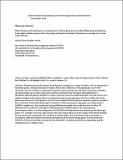Por favor, use este identificador para citar o enlazar a este item:
http://hdl.handle.net/10261/178721COMPARTIR / EXPORTAR:
 SHARE SHARE
 CORE
BASE CORE
BASE
|
|
| Visualizar otros formatos: MARC | Dublin Core | RDF | ORE | MODS | METS | DIDL | DATACITE | |

| Título: | Cloning and heterologous overexpression of three gap genes encoding different glyceraldehyde-3-phosphate dehydrogenases from the plant pathogenic bacterium Pseudomonas syringae pv. tomato strain DC3000 |
Autor: | El Khalfi, B.; Araya, José M.; Rodríguez-Castro, J.; Rey, Manuel; Soukri, A.; Serrano, Aurelio CSIC ORCID | Palabras clave: | Pseudomonas syringae pv tomato DC3000 Optimized overexpression Heterologous protein Paralogous gap genes Glyceraldehyde-3-phosphate dehydrogenase (GAPDH) |
Fecha de publicación: | 2013 | Editor: | Academic Press | Citación: | Protein Expression and Purification 89: 146- 155 (2013) | Resumen: | The gammaproteobacterium Pseudomonas syringae pv. tomato DC3000 is the causal agent of bacterial speck, a common disease of tomato. The mode of infection of this pathogen is not well understood, but according to molecular biological, genomic and proteomic data it produces a number of proteins that may promote infection and draw nutrients from the plant. Glyceraldehyde-3- phosphate dehydrogenase (GAPDH) is a major enzyme of carbon metabolism that was reported to be a surface antigen and virulence factor in other pathogenic microorganisms, but its possible role in the infection process of P. syringae has so far not been studied. Whole-genome sequence analyses revealed the occurrence in this phytopathogenic bacterium of three paralogous gap genes encoding distinct GAPDHs, namely two class I enzymes having different molecular mass subunits and one class III bifunctional D-erythrose-4-phosphate dehydrogenase/GAPDH enzyme. By using genome bioinformatics data, as well as alignments of both DNA and deduced protein sequences, the three gap genes of P. syringae were one-step cloned with a His-Tag in pET21a vector using a PCR-based strategy, and its expression optimized in E. coli BL21 to achieve high yield of the heterologous proteins. In accordance with their distinct molecular phylogenies, these bacterial gap genes encode functional GAPDHs of diverse molecular masses and nicotinamide-coenzyme specificities, suggesting specific metabolic and/or cellular roles. | URI: | http://hdl.handle.net/10261/178721 | DOI: | 10.1016/j.pep.2013.02.005 | Identificadores: | doi: http://dx.doi.org/10.1016/j.pep.2013.02.005 issn: 1046-5928 |
| Aparece en las colecciones: | (IBVF) Artículos |
Ficheros en este ítem:
| Fichero | Descripción | Tamaño | Formato | |
|---|---|---|---|---|
| Protein.pdf | 1,72 MB | Adobe PDF |  Visualizar/Abrir |
CORE Recommender
SCOPUSTM
Citations
4
checked on 29-mar-2024
WEB OF SCIENCETM
Citations
3
checked on 17-feb-2024
Page view(s)
420
checked on 18-abr-2024
Download(s)
241
checked on 18-abr-2024
Google ScholarTM
Check
Altmetric
Altmetric
NOTA: Los ítems de Digital.CSIC están protegidos por copyright, con todos los derechos reservados, a menos que se indique lo contrario.
